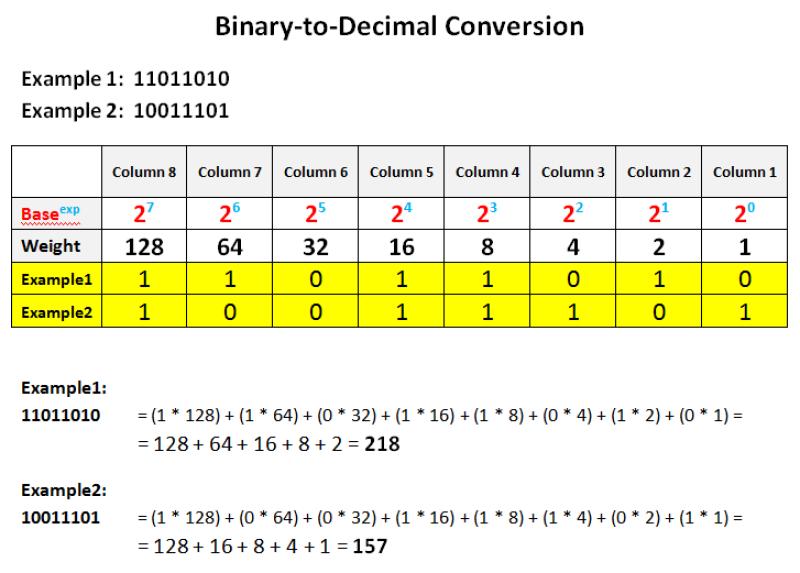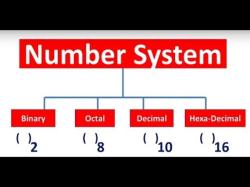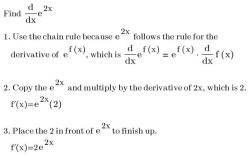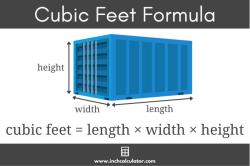How is a binary number converted to a decimal number?
Converting a binary number to a decimal number involves a step-by-step process of assigning place values to the binary digits and then performing the appropriate calculations. Here's a guide on how to convert a binary number to a decimal number:
Write Down the Binary Number: Begin with the binary number you want to convert to decimal. For example, let's use the binary number 1101.
Assign Place Values: Starting from the rightmost digit (the least significant bit) and moving left, assign place values that represent powers of 2. The rightmost digit gets a place value of 2^0, the next digit to the left gets 2^1, the next gets 2^2, and so on. Continue assigning increasing powers of 2 to each digit.
For the binary number 1101:
- Rightmost digit (1): 2^0 = 1
- Second-rightmost digit (0): 2^1 = 2
- Third-rightmost digit (1): 2^2 = 4
- Leftmost digit (1): 2^3 = 8
Calculate Decimal Values: For each digit, calculate the decimal value by raising 2 to the assigned power.
- 1 * 2^0 = 1 * 1 = 1 (rightmost digit)
- 0 * 2^1 = 0 * 2 = 0 (second-rightmost digit)
- 1 * 2^2 = 1 * 4 = 4 (third-rightmost digit)
- 1 * 2^3 = 1 * 8 = 8 (leftmost digit)
Add Up the Decimal Values: Sum the decimal values you calculated for each digit. In this example, it's 1 + 0 + 4 + 8 = 13.
Result: The sum from the previous step is the decimal equivalent of the binary number. In this case, the binary number 1101 is equal to the decimal number 13.
So, the binary number 1101 is equivalent to the decimal number 13.
You can use these steps to convert any binary number to its decimal equivalent. Just remember to assign the appropriate place values based on the position of each binary digit and then calculate the decimal values for each digit before adding them up.
Converting Binary to Decimal: The Step-by-Step Process
Converting binary numbers to their decimal equivalents is a fundamental skill in computer science and mathematics. Binary numbers, represented using only two digits, 0 and 1, serve as the basis for digital computation. Understanding the conversion process empowers individuals to decipher and interpret binary codes, essential for various applications.
Step-by-Step Guide:
Identify Binary Digits: Begin by identifying the individual binary digits, starting from the rightmost digit. Each digit represents a specific power of 2.
Multiply Digits by Corresponding Powers of 2: Multiply each binary digit by its corresponding power of 2. The rightmost digit represents 2^0, the next digit represents 2^1, and so on.
Add the Products: Sum the products obtained from step 2. The resulting sum represents the decimal equivalent of the binary number.
Example:
Convert the binary number 101101 to decimal:
Identify binary digits: 1, 0, 1, 1, 0, 1
Multiply each digit by its corresponding power of 2:1 * 2^5 = 320 * 2^4 = 01 * 2^3 = 81 * 2^2 = 40 * 2^1 = 01 * 2^0 = 1
Add the products:32 + 0 + 8 + 4 + 0 + 1 = 45
Therefore, the decimal equivalent of 101101 is 45.
Transforming Binary Numbers into Decimal Equivalents
Binary to decimal conversion revolves around the concept of the positional value system. In this system, each digit holds a value based on its position, with the rightmost digit representing the least significant bit (LSB) and the leftmost digit representing the most significant bit (MSB).
In binary numbers, the value of a digit is either 0 or 1. If a digit is 1, it contributes its corresponding power of 2 to the overall value. If a digit is 0, it does not contribute to the overall value.
By multiplying each binary digit by its corresponding power of 2 and adding the products, we can determine the decimal equivalent of the binary number.
Understanding the Conversion of Binary to Decimal Numbers
To fully grasp binary to decimal conversion, it is essential to understand the underlying principles:
Positional Value: Each digit in a binary number holds a value based on its position, with each position representing a specific power of 2.
Powers of 2: Binary numbers use only two digits, 0 and 1, to represent numbers. This representation is achieved through the use of powers of 2.
Decimal Equivalent: The decimal equivalent of a binary number is the value it represents in the decimal number system.
Conversion Process: The conversion process involves multiplying each binary digit by its corresponding power of 2 and adding the products.
Practice and Understanding:
Mastering binary to decimal conversion requires practice and a thorough understanding of the concepts. Here are some tips for enhancing your skills:
Practice with Simple Examples: Start by converting small binary numbers to decimals to gain familiarity with the process.
Utilize Conversion Tools: Online calculators or conversion tools can assist in verifying your answers and providing additional practice opportunities.
Learn the Inverse Process: Understand how to convert decimal numbers to binary numbers to deepen your comprehension of the relationship between the two systems.
Apply Conversion in Real-World Scenarios: Seek opportunities to apply binary to decimal conversion in practical settings, such as interpreting binary codes or understanding digital data representation.












